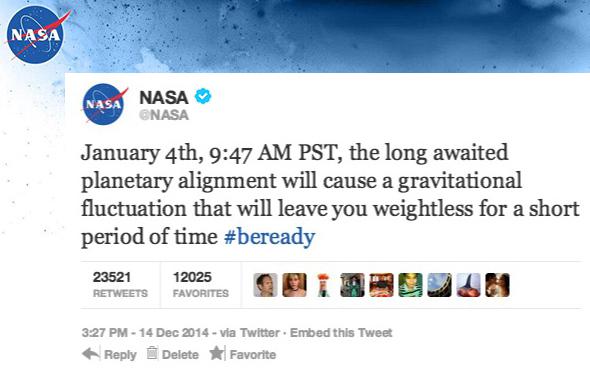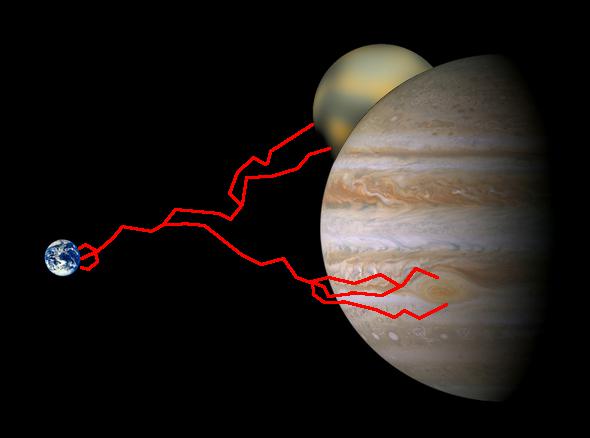The very first nonsense I had to debunk in 2014 was a claim that on Jan. 4 of that year a planetary alignment would cause gravity to decrease, allowing you to float momentarily or fall more slowly if you jumped in the air at the right moment: “Zero G Day.” This exact same hoax has resurfaced this week in a couple of places, so I’ve decided to update the debunking to include some new links and repost it, hopefully to stem the tide of silliness at year’s end. It seems fitting that (hopefully) this is also the last debunking I’ll make in 2014. But who knows? There’s still a week left.
Something you’ll never hear me say: “Well, now I’ve heard it all.”
Long experience has taught me there is always a sillier claim. Always. And you’re hearing that from a guy who has debunked the ideas that the Maya calendar predicted the end of the world, that the “Supermoon” caused earthquakes, and that a magnetic pole flip of the Earth will cause superstorms (and another saying the Earth is already physically starting to flip over).
So what’s sillier than these? Well, we now have the claim that early next year—on Jan. 4, 2015 at 09:47 PST to be exact—due to the combined gravity of Jupiter and Pluto, you will be able to jump in the air and float for just a couple of seconds (or at least fall more slowly, depending on different “sources”).
It’s hard for me to overstate just how wrong this claim is. First off, this exact same hoax was pulled last year, in 2014, by a site called News Hound (now offline, apparently), and a lot of people fell for it. Here we are again, a year later, back at the same spot. This time the joke is being made by a “news” site called Daily Buzz Live (which didn’t even bother to change much of the wording of the original hoax). They even have a picture of a NASA tweet about the event:

Photo from Daily Buzz Live
There’s only one problem: That picture is completely fake. NASA never tweeted it, and it was presumably made up wholesale for the article on Daily Buzz Live. Whoever did it was clever, adding the number of retweets and favorites, but it’s as fake as a $20 iPhone you can buy on the street in New York City.
After all, the physics of “Zero G Day” is wrong, the claim about Pluto and Jupiter is wrong, and—and this part is the real killer—it’s based on a joke made by an astronomer nearly 40 years ago!
Despite this, it’s spreading around Facebook (and Twitter) so much once again that I got a lot of people asking or telling me about it. That’s why I’m debunking this thing again.
So to get started, here’s the claim:
It has been revealed by the British astronomer Patrick Moore that, on the morning of January 4th 2014, an extraordinary astronomical event will occur. At exactly 9:47 am, the planet Pluto will pass directly behind Jupiter, in relation to the Earth. This rare alignment will mean that the combined gravitational force of the two planets would exert a stronger tidal pull, temporarily counteracting the Earth’s own gravity and making people weigh less. Moore calls this the Jovian-Plutonian Gravitational Effect.
Yeah, except this is all baloney. To be polite. OK, so why is this wrong?
Pluto and Jupiter, Sitting in a Tree …
First of all, the gravitational forces of the other planets in the solar system have essentially zero effect on you personally.
And we’re done. Full stop.
OK, fine, I’ll give some brief details. The planets are big objects with lots of gravity, but that only affects you if you’re close to them. Space, however, is big—that’s why we call it space—and planets are far away. This weakens their gravity on you hugely, reducing it to less than the impact of the flutter of a butterfly’s wing.

Photo by Shutterstock/Jaimie Duplass
If you want the math, then here you go: Even if you add all of the planets together, they pull on you with a force less than 2 percent of that of the Moon! The Daily Buzz Live article mentions tides, too, but that’s even worse: The combined tidal force from the planets is far less, like 0.005 percent of the Moon’s! Simply put, the planets are just too far away to have any real effect on you. By the way, the Moon orbits the Earth on an ellipse, so its own gravity fluctuates far more than the combined strength of the planets every two weeks.
Note that you cannot float in the air every two weeks.
And specifically, the gravity from Pluto is weakest of them all. Pluto is a teeny tiny ice ball, far smaller than even our Moon … and at its closest it’s flippin’ 4 billion kilometers (2.5 billion miles) from Earth. That’s a long way. A car on the road half a kilometer away has more gravitational pull on you than Pluto does.
In fact, doing the math, I find that the Earth pulls on you about 200 trillion times harder than Pluto does. That’s about the same ratio as the number of cells in your body to a single cell … so this claim that you can float is like saying you can shed a single cell and fly away by flapping your arms.
Location3
It gets worse (amazingly). The article says Pluto will be “directly behind Jupiter” on Jan. 4, 2015. I checked: On that day they are on nearly opposite sides of the sky. They’re really far apart, about 145°. You couldn’t have picked a much worse date to claim Pluto was behind Jupiter.
So the physics of the claim is ridiculous. But the origin of the claims makes it even funnier.

Photo by Shutterstock/simekesh
Fool Me Once, Shame on You
The article on Daily Buzz Live mentions that this claim came from Patrick Moore. He was a real astronomer in the U.K., an enormously popular radio and television science program presenter—he predated Carl Sagan and is still considered an icon of science in England.
The wonderful thing about all this is: Moore actually did make this claim! However, as Snopes.com points out, it was an April Fools’ Day joke. Moore made this claim in 1976 on his radio program. To my complete unsurprise, apparently some folks called in to say they did feel the effect! This is called “priming,” where you tell people in advance that they’ll feel something due to some cause, and they will, even if the cause never happened. It’s used by ghost hunters and ghost tour guides quite a bit, to spook people before they actually enter a “haunted house,” guaranteeing they’ll feel chills as they walk from room to room. I’ve seen this myself first hand: People can convince themselves of amazing things that never actually happened.
Hope Floats
So there you go: It’s a repeat of a silly claim based on a joke in the first place.
I know a lot of people reading this right now are slapping their foreheads and wondering how people can be so stupid as to fall for this. I understand this reaction, but I don’t share it. Smart people fall for silly things all the time, and intelligence isn’t really the prime factor here.

Photo by Shutterstock/Glenn Price
Skepticism is. In general, schools don’t teach people how to analyze a claim, how to tell if something makes sense on the surface of it, or how to go about looking into the claim. I knew right away to do the math, and to see if Pluto and Jupiter really were aligned as the article says. But all too often, people don’t think carefully (or at all) about these claims, and simply spread them through social media. All it takes is literally the click of a “Share” button. Pseudoscience thrives via this virulence, whereas truth must take a harder path.
In fact, that’s why I bother debunking stuff like this. Sure, this is a silly claim, and probably harmless in practice. But not all of them are; I already mentioned the “Mayan Notpocalypse” from 2012, and I can tick off a dozen other doomsday or scary claims that spread due to a lack of skepticism. And of course there are real issues like global warming denial, anti-vaccination, and more, which live and breathe and spread due to a lack of skepticism in the public.
In my original post about this in January 2014, I said, “This particular bit of fluff will dry up and float away in a day or two, but those others are here to stay for a long time.” I was wrong, and I should’ve known that something like this would resurface again in a year; it’s like the “Mars as big as the Moon” nonsense that comes back year after year.
Still, my hope is that every time we take a moment to inject a bit of (polite) skepticism into people’s everyday lives, it makes the world a slightly better place to be.
If enough of us do it often enough, we can change “slightly” to “magnificently.”
